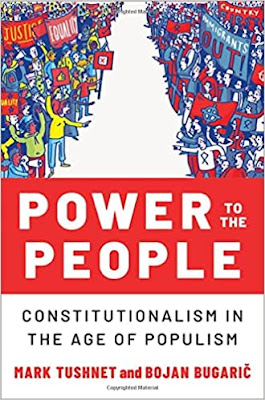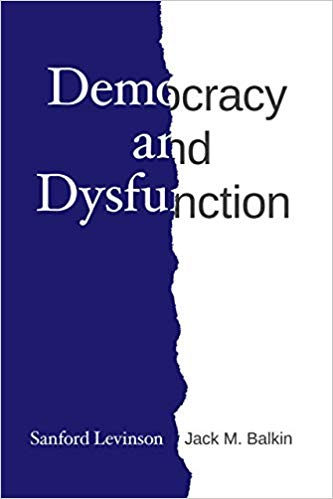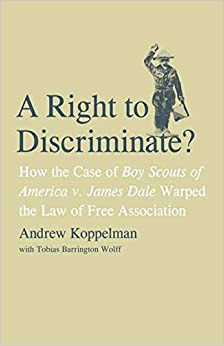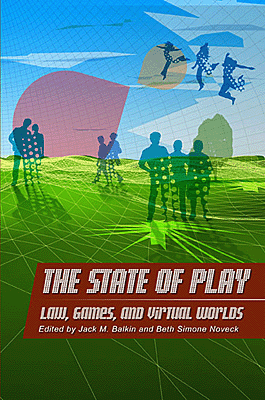Balkinization
an unanticipated consequence of
Jack M. Balkin
Balkinization Symposiums: A Continuing List
E-mail:
Jack Balkin:
jackbalkin at yahoo.com
Bruce Ackerman
bruce.ackerman at yale.edu
Ian Ayres
ian.ayres at yale.edu
Corey Brettschneider
corey_brettschneider at brown.edu
Mary Dudziak
mary.l.dudziak at emory.edu
Joey Fishkin
joey.fishkin at gmail.com
Heather Gerken heather.gerken at yale.edu
Abbe Gluck abbe.gluck at yale.edu
Mark Graber
mgraber at law.umaryland.edu
Stephen Griffin
sgriffin at tulane.edu
Jonathan Hafetz
jonathan.hafetz at shu.edu
Jeremy Kessler
jkessler at law.columbia.edu
Andrew Koppelman
akoppelman at law.northwestern.edu
Marty Lederman
msl46 at law.georgetown.edu
Sanford Levinson
slevinson at law.utexas.edu
David Luban
david.luban at gmail.com
Gerard Magliocca
gmaglioc at iupui.edu
Jason Mazzone
mazzonej at illinois.edu
Linda McClain
lmcclain at bu.edu
John Mikhail
mikhail at law.georgetown.edu
Frank Pasquale
pasquale.frank at gmail.com
Nate Persily
npersily at gmail.com
Michael Stokes Paulsen
michaelstokespaulsen at gmail.com
Deborah Pearlstein
dpearlst at yu.edu
Rick Pildes
rick.pildes at nyu.edu
David Pozen
dpozen at law.columbia.edu
Richard Primus
raprimus at umich.edu
K. Sabeel Rahmansabeel.rahman at brooklaw.edu
Alice Ristroph
alice.ristroph at shu.edu
Neil Siegel
siegel at law.duke.edu
David Super
david.super at law.georgetown.edu
Brian Tamanaha
btamanaha at wulaw.wustl.edu
Nelson Tebbe
nelson.tebbe at brooklaw.edu
Mark Tushnet
mtushnet at law.harvard.edu
Adam Winkler
winkler at ucla.edu
Compendium of posts on Hobby Lobby and related cases
The Anti-Torture Memos: Balkinization Posts on Torture, Interrogation, Detention, War Powers, and OLC
The Anti-Torture Memos (arranged by topic)
Recent Posts
Prison and Death
Just A Few Blogs
ACS Blog
Alas, a Blog
Althouse
Arts and Letters Daily
Atrios (Eschaton)
Bill of Health
Buzzflash.com
Buzz Machine
Cato at Liberty
Juan Cole (Informed Comment)
Concurring Opinions
The Constitution in 2020
Corrente
Crooked Timber
Daily Howler
Daily Kos
Dana Boyd
Brad DeLong
Digby (Hullabaloo)
Discriminations
Daniel Drezner
Kevin Drum (Mother Jones)
Electrolite
En Banc
Eunomia (Daniel Larison)
Fafblog
Michael Froomkin (Discourse.net)
GovLab (Beth Noveck)
Rick Hasen (Election Law)
History News Network
How Appealing
Ignatz (Sam Heldman)
The Importance of (Ernie Miller)
Infolaw
Instapundit
International Economic Law and Policy Blog
IntLawGrrls
Jacob Levy
Jesus' General
Jurisdynamics
The Kitchen Cabinet
Mark Kleiman
Law Blog Central
Larry Lessig
Lawyers, Guns and Money
Liberal Oasis
Brian Leiter's Law School Reports
The Leiter Reports
Marginal Revolution
Megan McArdle
Memeorandum
Metafilter
Mirror of Justice
The New Republic
Newseum
No More Mister Nice Blog
Brendan Nyhan
Opinio Juris
Orcinus
The Originalism Blog
Pandagon
Passport (Foreign Policy)
Overcoming Bias
Political Animal (Washington Monthly)
Political Theory Daily Review
Political Wire (Taegan Goddard)
The Poor Man
Virginia Postrel
Prawfsblawg
Public Reason
Jonathan Rauch
Raw Story
Redstate
ReligiousLeftLaw.com
Reporters Committee For Freedom of the Press
Reproductive Rights Blog
Rothman's Roadmap to the Right of Publicity
SCOTUS Blog
Seeing the Forest
Clay Shirky
The Shifted Librarian
The Situationist
Larry Solum (Legal Theory)
Andrew Sullivan
Talking Points Memo
Talk Left
Tapped
Tbogg
TechPresident
The Paper Chase (Jurist)
Tom Paine
Tom Tomorrow (This Modern World)
Eve Tushnet
Uggabugga
University of Chicago Law School Faculty Blog
Unqualified Offerings
The Volokh Conspiracy
War and Piece (Laura Rozen)
Wampum
Oliver Willis
Wonkette
Written Description
Matthew Yglesias
Yin
Your Choice of Feeds
1. XML
powered by
2. Atom Feed
3. RSS 2.0
Prison and Death
Guest Blogger
For the Balkinization symposium on Judith Resnik, Impermissible Punishments: How Prison Became a Problem for Democracy (University of Chicago Press, 2025).
Carol S. Steiker Judith Resnik has produced a
magisterial, learned, and deeply humane work of history, law, and policy that
takes us deep within the deeply flawed institution of the American prison. As a scholar of American criminal justice who
focuses on the death penalty, I found many resonances in Resnik’s book to my
own primary preoccupation. Capital
punishment makes only the occasional, peripheral appearance in Resnik’s account
of the prison (this is not a criticism, as the book is a mammoth doorstopper as
it is). But reflecting on the interplay
between these two penal practices is a worthwhile extension of Resnik’s work,
as it both amplifies and complicates some of her key themes. The relationship of the prison to the
death penalty has always been complex. In
some ways, their fates often seem inextricably linked, like those of conjoined
twins. In other ways, the two practices seem
more like rival siblings locked in a zero-sum battle. Consideration of four key time periods—the
early to mid-nineteenth century, the Progressive Era, the 1960s and ‘70s, and
the first decades of the twenty-first century—sheds light on many of the key
convergences and divergences of the two practices and may suggest some
important questions for their future. The early to mid-nineteenth century
saw the birth of the modern prison. As
Resnik explains, its supporters saw themselves as forward-thinking reformers
who rejected many of the punishments that had dominated in the eighteenth-century,
such as “whipping, executions, branding, confinement, or exile to colonies” (p.
20). But the new prisons brought their
own horrors. The Quaker-inspired Eastern
State Penitentiary, which opened in Philadelphia in 1829, insisted on strict
solitary confinement in order to induce repentance, employing a form of
psychological torture that has continued into the present day. The new prisons also imposed coerced labor, a
requirement they enforced through severe corporal chastisement. Coerced labor and physical violence are again
legacies that can be traced to this founding moment. Many of the same reformers who
endorsed the new American prisons also supported the death penalty abolition
movement that swept through the Northeast and Midwest in the same period. Present-day Europeans are often surprised to
learn that several American states were among the first jurisdictions in the
world to abolish the death penalty, with Michigan abolishing the death penalty
for murder in 1846, followed by Rhode Island in 1852 and Wisconsin in
1853. Many other states introduced and
vigorously debated abolition bills, with some coming quite close to success and
with others producing substantial reforms in lieu of wholesale abolition. In some respects, these parallel reform
movements represent an example of the “conjoined twins” relationship of prison
and death, as nineteenth-century penal reformers took a holistic approach to
modernizing punishment practices. The
two reform movements also echoed one another in that they both enjoyed only
partial success, with the new prisons employing often brutal practices that
even at the time engendered criticism and with the anti-death-penalty movement
achieving only a few full abolitions. But
this period also clearly exemplifies the “sibling rivals” aspect of the two
modes of punishment as well. The
anti-death-penalty reformers made this relationship quite explicit. They argued that the new prisons reduced the
need for reliance on capital punishment and that the new penology of redemption
through penitence and labor was inconsistent with the punishment of death. As Resnik herself succinctly puts this
“lesson” more broadly, “[T]o bring a punishment to its end has entailed
promoting replacements” (p. 578). Fast forward to the Progressive Era,
the next major period of reform in penal practices. This period, too, saw reformers taking aim at
carceral and capital practices alike. With
regard to prisons, Resnik describes the many important reforms that were born
during this era, including “conditional release programs such as probation and
parole” and the building of “‘open prisons’ without perimeter barriers” (p. 608). However, reformers’ penal objectives did not
stop at prison innovation. With regard
to capital punishment, the Progressive Era was one of most significant periods
of abolition in American history, with 10 states repealing their capital statutes
between 1897 and 1917. But as was the case earlier in the
nineteenth century, this period of reform had its dark legacies and
failures. The same Progressives who
touted prison reform also often embraced the racially inflected “science” of eugenics,
a legacy that Resnik explains would dog the primary transnational organization
of prison administration (the IPPC) through the Nazi era and into the post-War
period (pp. 103-48). With regard to the
death penalty, eight of the 10 states that achieved abolition during the
Progressive Era ended up reinstating the death penalty, often within only a few
years of abolition. Why? This era was also the most active era of
race-based lynching in the United States.
Many political leaders were dismayed by such incidents in their states,
which they viewed as representing the deterioration of the rule of law and the
weakness of their own political authority.
The death penalty was reinstated as a more benign substitute for the
chaos and violence of lynchings. In the
case of both prison reform and death penalty abolition, transformative change in
the Progressive era was blighted by the continuing taint of racism—a theme that
runs throughout Resnik’s account. Although the fates of prison reform
and death penalty abolition in this era were linked by the pernicious pall of
American racism, they also diverged in the opposite way from earlier in the
century. The birth of the prison enabled
a robust mid-century abolition movement by providing a plausible substitute for
the death penalty. But it was precisely prison’s
perceived failure as a substitute for death—especially in cases of Black
men accused of raping white women—that led death penalty abolition to founder
during the Progressive era. In such
cases, many legislatures concluded that death and only death would be
sufficient punishment to forestall mob violence—and even then, only when the
death penalty was speedy and certain.
The practice of what historians have called “legal lynchings” was born
in this period, as many Southern jurisdictions sought to contain mob violence
by promising swift executions after the most minimal judicial process possible—a
legacy that lived on until well into the twentieth century. It was not until the 1960s that the
nation began dealing in earnest with its long and ignoble history of racial
discrimination, with repercussions for both carceral and capital
practices. As Resnik recounts, the first
time that a form of prison discipline was ruled unconstitutional was in 1968,
when Judge Harry Blackmun (then a judge on the Eighth Circuit) held that whipping
violated the newly incorporated “cruel and unusual punishments” proscription of
the Eighth Amendment (p. 2). On the
capital side, the Supreme Court struck down the death penalty as it was then
applied across the country in 1972 in its landmark decision of Furman v.
Georgia, 408 U.S. 238 (1972). Once
again, the prison and the execution chamber were joint targets of reformers,
this time of judicial regulation under the constitution. In neither context did the courts
describe their motivation as addressing racial injustice, though the subtext
was clear. In the Arkansas whipping
case, the trial record “established that the state forced prisoners to pick
cotton, okra, and cucumbers six days a week, ten or more hours a day” (p.
2). And in Furman, the court used
phrases like “wanton and freakish” and “struck by lightning” to describe the
application of the death penalty, in what many read as only slightly veiled
code for racial discrimination. But the Eighth Amendment did not prove
to be a robust palliative in either context.
Resnik describes how the Supreme Court weakened the power of
constitutional prison litigation over time, requiring that suffering be
“extreme” and “unnecessary” to state a claim for relief (p. 500), and she draws
an explicit connection to the Court’s rulings about modes of execution, which
upheld methods that “were not designed to ‘superad[d] . . . terror, pain, or
disgrace’” (p. 501). The two contexts also shared a similar
trajectory over the next quarter century, as prison populations soared and
execution rates reached highs not seen since the 1950s. The “tough on crime” politics of the 1980s
and 1990s continually upped the ante with regard to both incarceration and
death. With regard to both carceral and
capital practices, the U.S. held—and continues to hold—itself apart from a
growing consensus among our peer nations that punishment practices should be
constrained by a commitment to fundamental human rights to dignity and life. Starting at the turn of the
millennium, however, a sharp divergence emerged between the trajectories of
incarceration and capital punishment.
The use of the death penalty, whether measured by executions or new
death sentences, went into freefall.
Today, those numbers are down 80 or 90 percent of their 1990s
highs. Mass (or “massive” in Resnik’s
terminology, p. 10) incarceration eventually began to recede as well about a
decade later but has shrunk considerably less. One explanation for this divergence lies
(again) in the “sibling rivals” account of the relationship of prison to
death. Opponents of the death penalty
welcomed the introduction of the sentence of life without parole (LWOP) because
capital jurors and opinion poll respondents overwhelmingly reported themselves
more willing to forgo a death sentence when LWOP was an option. But LWOP spread well beyond its initial
promulgation as an alternative to death for capital crimes, driving up prison
populations even as it drove down capital sentencing. Now LWOP is available in many non-capital contexts,
part of what Resnik terms an overall strategy of “aggressive incarceration”
(pp. 584-86). Another explanation lies in the
different way that Eighth Amendment regulation has played out in the two
contexts. With regard to prison
conditions, few would say that constitutional litigation has fundamentally
reshaped the contours of American incarceration. Yet that is exactly what happened with regard
to the death penalty. Yes, the Court scaled
back its initial promise to reform and rationalize the practice of capital
punishment under the Eighth Amendment.
But no one would argue that the federal courts are not a—or even the—central
player in shaping capital practices. Which
offenders and offenses are eligible for death, what is permitted and required
in capital representation and capital trials, and how executions may be
conducted—all of these questions are regularly presented to and decided by
federal courts. The growth of
constitutionally mandated mitigation practice, along with the lengthy delays
and high costs driven (unintentionally) by constitutional regulation, have contributed
to the dramatic decline in the use of the death penalty. Capital punishment is much more a creature of
the judicial process than is the prison, which more resembles schools,
hospitals, and other large-scale institutions that are resistant to effective judicial
oversight. American prisons are shaped much
more by politicians and administrators than by courts. Ironically and disturbingly, the
lengthy delays driven by constitutional regulation of capital punishment have
led to the greatest single greatest convergence between prison and death. In the American capital system, sentences of “death”
have become in reality sentences of extremely lengthy incarceration that most
likely will not be followed by execution.
Only a minority of those sentenced to death in the past several decades
have been executed. In California, which
houses the nation’s largest death-sentenced population, execution is not the
leading cause of death on death row. It
is not even the second leading cause of death. Rather, execution comes in third, after
suicide and natural causes. The average length
of time on death row nationwide now tops more than two decades. And death row conditions are often among the
harshest that prisons have to offer, with inmates frequently held in solitary
confinement or other extremely restrictive conditions. Meanwhile, the primary alternative to
punishment by death—the sentence of life without possibility of parole, looks
increasingly similar to a death sentence.
Indeed, advocates opposed to life without parole highlight that
similarity by referring to LWOP as a sentence of “death in prison.” In our current system, prison has become
death and death has become prison. Against this backdrop, what can we
predict or propose for the future of the prison and the death penalty? In the present moment of weaponized fear mongering
and the return of tough-on-crime rhetoric (even at a time of historically low
crime rates), Resnik’s call for a principle of “anti-ruination” shines a needed
spotlight on the risks that punishment practices—non-capital and capital
alike—pose for the future of democratic governance. Posited as a moral and political obligation,
anti-ruination helpfully builds on concepts like dignity and autonomy to offer
a bulwark of rights-based protection against ruinous punishments. Brutal prison and death row conditions,
capital punishment, sentences of life without possibility of parole, lengthy
solitary confinement, and lengthy prison sentences imposed on juvenile
offenders are all potential candidates for such a designation. Resnik’s conceptualization offers a framework
for policymakers to use to assess these and other practices. And though she does not go this far herself,
Resnik’s framework offers a blueprint for human rights lawyers and
constitutional litigators to try to convert her compelling vision into binding
law. Carol S. Steiker is the Henry J.
Friendly Professor of Law at Harvard Law School. You can reach her by email at
steiker@law.harvard.edu.
Posted
9:30 AM
by Guest Blogger [link]
Books by Balkinization Bloggers

Linda C. McClain and Aziza Ahmed, The Routledge Companion to Gender and COVID-19 (Routledge, 2024)

David Pozen, The Constitution of the War on Drugs (Oxford University Press, 2024)

Jack M. Balkin, Memory and Authority: The Uses of History in Constitutional Interpretation (Yale University Press, 2024)

Mark A. Graber, Punish Treason, Reward Loyalty: The Forgotten Goals of Constitutional Reform after the Civil War (University of Kansas Press, 2023)

Jack M. Balkin, What Roe v. Wade Should Have Said: The Nation's Top Legal Experts Rewrite America's Most Controversial Decision - Revised Edition (NYU Press, 2023)

Andrew Koppelman, Burning Down the House: How Libertarian Philosophy Was Corrupted by Delusion and Greed (St. Martin’s Press, 2022)

Gerard N. Magliocca, Washington's Heir: The Life of Justice Bushrod Washington (Oxford University Press, 2022)

Joseph Fishkin and William E. Forbath, The Anti-Oligarchy Constitution: Reconstructing the Economic Foundations of American Democracy (Harvard University Press, 2022)

Mark Tushnet and Bojan Bugaric, Power to the People: Constitutionalism in the Age of Populism (Oxford University Press 2021).

Mark Philip Bradley and Mary L. Dudziak, eds., Making the Forever War: Marilyn B. Young on the Culture and Politics of American Militarism Culture and Politics in the Cold War and Beyond (University of Massachusetts Press, 2021).

Jack M. Balkin, What Obergefell v. Hodges Should Have Said: The Nation's Top Legal Experts Rewrite America's Same-Sex Marriage Decision (Yale University Press, 2020)

Frank Pasquale, New Laws of Robotics: Defending Human Expertise in the Age of AI (Belknap Press, 2020)

Jack M. Balkin, The Cycles of Constitutional Time (Oxford University Press, 2020)

Mark Tushnet, Taking Back the Constitution: Activist Judges and the Next Age of American Law (Yale University Press 2020).

Andrew Koppelman, Gay Rights vs. Religious Liberty?: The Unnecessary Conflict (Oxford University Press, 2020)

Ezekiel J Emanuel and Abbe R. Gluck, The Trillion Dollar Revolution: How the Affordable Care Act Transformed Politics, Law, and Health Care in America (PublicAffairs, 2020)

Linda C. McClain, Who's the Bigot?: Learning from Conflicts over Marriage and Civil Rights Law (Oxford University Press, 2020)

Sanford Levinson and Jack M. Balkin, Democracy and Dysfunction (University of Chicago Press, 2019)

Sanford Levinson, Written in Stone: Public Monuments in Changing Societies (Duke University Press 2018)

Mark A. Graber, Sanford Levinson, and Mark Tushnet, eds., Constitutional Democracy in Crisis? (Oxford University Press 2018)

Gerard Magliocca, The Heart of the Constitution: How the Bill of Rights became the Bill of Rights (Oxford University Press, 2018)

Cynthia Levinson and Sanford Levinson, Fault Lines in the Constitution: The Framers, Their Fights, and the Flaws that Affect Us Today (Peachtree Publishers, 2017)

Brian Z. Tamanaha, A Realistic Theory of Law (Cambridge University Press 2017)

Sanford Levinson, Nullification and Secession in Modern Constitutional Thought (University Press of Kansas 2016)

Sanford Levinson, An Argument Open to All: Reading The Federalist in the 21st Century (Yale University Press 2015)

Stephen M. Griffin, Broken Trust: Dysfunctional Government and Constitutional Reform (University Press of Kansas, 2015)

Frank Pasquale, The Black Box Society: The Secret Algorithms That Control Money and Information (Harvard University Press, 2015)

Bruce Ackerman, We the People, Volume 3: The Civil Rights Revolution (Harvard University Press, 2014)
Balkinization Symposium on We the People, Volume 3: The Civil Rights Revolution

Joseph Fishkin, Bottlenecks: A New Theory of Equal Opportunity (Oxford University Press, 2014)

Mark A. Graber, A New Introduction to American Constitutionalism (Oxford University Press, 2013)

John Mikhail, Elements of Moral Cognition: Rawls' Linguistic Analogy and the Cognitive Science of Moral and Legal Judgment (Cambridge University Press, 2013)

Gerard N. Magliocca, American Founding Son: John Bingham and the Invention of the Fourteenth Amendment (New York University Press, 2013)

Stephen M. Griffin, Long Wars and the Constitution (Harvard University Press, 2013)

Andrew Koppelman, The Tough Luck Constitution and the Assault on Health Care Reform (Oxford University Press, 2013)

James E. Fleming and Linda C. McClain, Ordered Liberty: Rights, Responsibilities, and Virtues (Harvard University Press, 2013)
Balkinization Symposium on Ordered Liberty: Rights, Responsibilities, and Virtues

Andrew Koppelman, Defending American Religious Neutrality (Harvard University Press, 2013)

Brian Z. Tamanaha, Failing Law Schools (University of Chicago Press, 2012)

Sanford Levinson, Framed: America's 51 Constitutions and the Crisis of Governance (Oxford University Press, 2012)

Linda C. McClain and Joanna L. Grossman, Gender Equality: Dimensions of Women's Equal Citizenship (Cambridge University Press, 2012)

Mary Dudziak, War Time: An Idea, Its History, Its Consequences (Oxford University Press, 2012)

Jack M. Balkin, Living Originalism (Harvard University Press, 2011)

Jason Mazzone, Copyfraud and Other Abuses of Intellectual Property Law (Stanford University Press, 2011)

Richard W. Garnett and Andrew Koppelman, First Amendment Stories, (Foundation Press 2011)

Jack M. Balkin, Constitutional Redemption: Political Faith in an Unjust World (Harvard University Press, 2011)

Gerard Magliocca, The Tragedy of William Jennings Bryan: Constitutional Law and the Politics of Backlash (Yale University Press, 2011)

Bernard Harcourt, The Illusion of Free Markets: Punishment and the Myth of Natural Order (Harvard University Press, 2010)

Bruce Ackerman, The Decline and Fall of the American Republic (Harvard University Press, 2010)
Balkinization Symposium on The Decline and Fall of the American Republic

Ian Ayres. Carrots and Sticks: Unlock the Power of Incentives to Get Things Done (Bantam Books, 2010)

Mark Tushnet, Why the Constitution Matters (Yale University Press 2010)
Ian Ayres and Barry Nalebuff: Lifecycle Investing: A New, Safe, and Audacious Way to Improve the Performance of Your Retirement Portfolio (Basic Books, 2010)
.jpg)
Jack M. Balkin, The Laws of Change: I Ching and the Philosophy of Life (2d Edition, Sybil Creek Press 2009)

Brian Z. Tamanaha, Beyond the Formalist-Realist Divide: The Role of Politics in Judging (Princeton University Press 2009)

Andrew Koppelman and Tobias Barrington Wolff, A Right to Discriminate?: How the Case of Boy Scouts of America v. James Dale Warped the Law of Free Association (Yale University Press 2009)

Jack M. Balkin and Reva B. Siegel, The Constitution in 2020 (Oxford University Press 2009)
Heather K. Gerken, The Democracy Index: Why Our Election System Is Failing and How to Fix It (Princeton University Press 2009)

Mary Dudziak, Exporting American Dreams: Thurgood Marshall's African Journey (Oxford University Press 2008)

David Luban, Legal Ethics and Human Dignity (Cambridge Univ. Press 2007)

Ian Ayres, Super Crunchers: Why Thinking-By-Numbers is the New Way to be Smart (Bantam 2007)

Jack M. Balkin, James Grimmelmann, Eddan Katz, Nimrod Kozlovski, Shlomit Wagman and Tal Zarsky, eds., Cybercrime: Digital Cops in a Networked Environment (N.Y.U. Press 2007)

Jack M. Balkin and Beth Simone Noveck, The State of Play: Law, Games, and Virtual Worlds (N.Y.U. Press 2006)

Andrew Koppelman, Same Sex, Different States: When Same-Sex Marriages Cross State Lines (Yale University Press 2006)
Brian Tamanaha, Law as a Means to an End (Cambridge University Press 2006)
Sanford Levinson, Our Undemocratic Constitution (Oxford University Press 2006)
Mark Graber, Dred Scott and the Problem of Constitutional Evil (Cambridge University Press 2006)
Jack M. Balkin, ed., What Roe v. Wade Should Have Said (N.Y.U. Press 2005)
Sanford Levinson, ed., Torture: A Collection (Oxford University Press 2004)
Balkin.com homepage
Bibliography
Conlaw.net
Cultural Software
Writings
Opeds
The Information Society Project
BrownvBoard.com
Useful Links
Syllabi and Exams